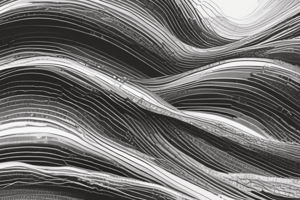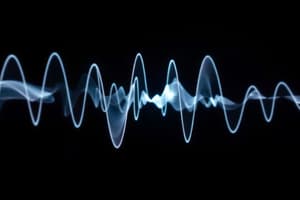Podcast
Questions and Answers
What is a pulse?
What is a pulse?
- A wave that remains in the same position
- A repeated disturbance that moves through a medium
- A single disturbance that moves through a medium (correct)
- A type of wave that can only travel through air
What occurs when you flick one end of a rope?
What occurs when you flick one end of a rope?
- The rope breaks
- The rope remains stationary
- The disturbance moves along the rope (correct)
- The disturbance remains at the end of the rope
What is an example of a transverse pulse?
What is an example of a transverse pulse?
- A wave moving horizontally through a slinky
- A wave moving vertically through a slinky
- A wave moving horizontally through a rope
- A wave moving vertically through a rope (correct)
What is the definition of a transverse pulse?
What is the definition of a transverse pulse?
What is the amplitude of a pulse?
What is the amplitude of a pulse?
What unit is used to measure the amplitude of a pulse?
What unit is used to measure the amplitude of a pulse?
What is the pulse length?
What is the pulse length?
Why are amplitude and pulse length important?
Why are amplitude and pulse length important?
What is the unit of amplitude?
What is the unit of amplitude?
What is pulse length?
What is pulse length?
What is the formula to calculate pulse speed?
What is the formula to calculate pulse speed?
What is the principle of superposition?
What is the principle of superposition?
What happens when two pulses meet and their disturbances add together?
What happens when two pulses meet and their disturbances add together?
What is the definition of destructive interference?
What is the definition of destructive interference?
What happens to the amplitude of a pulse after constructive interference?
What happens to the amplitude of a pulse after constructive interference?
What is the condition for destructive interference to occur?
What is the condition for destructive interference to occur?
What happens when two pulses with equal and opposite amplitudes meet?
What happens when two pulses with equal and opposite amplitudes meet?
What is the result of superposition of two pulses?
What is the result of superposition of two pulses?
What is the primary characteristic of a pulse?
What is the primary characteristic of a pulse?
In a transverse pulse, what is the direction of the displacement of the medium?
In a transverse pulse, what is the direction of the displacement of the medium?
What is the significance of pulse length in understanding pulses?
What is the significance of pulse length in understanding pulses?
What is the maximum disturbance of a medium measured in?
What is the maximum disturbance of a medium measured in?
What happens when a pulse is created in a rope?
What happens when a pulse is created in a rope?
What is the relationship between the amplitude and pulse length of a pulse?
What is the relationship between the amplitude and pulse length of a pulse?
What is the purpose of measuring the amplitude of a pulse?
What is the purpose of measuring the amplitude of a pulse?
What can be inferred about the movement of a pulse?
What can be inferred about the movement of a pulse?
What is the quantity that remains constant over time during an investigation of a pulse?
What is the quantity that remains constant over time during an investigation of a pulse?
What is the unit of measurement for pulse speed?
What is the unit of measurement for pulse speed?
What happens to the amplitude of a pulse after it undergoes destructive interference?
What happens to the amplitude of a pulse after it undergoes destructive interference?
What is the result of the superposition of two pulses with equal and opposite amplitudes?
What is the result of the superposition of two pulses with equal and opposite amplitudes?
What is the principle that describes the interaction of two or more pulses?
What is the principle that describes the interaction of two or more pulses?
What type of interference occurs when two pulses meet and their disturbances add together to create a larger pulse?
What type of interference occurs when two pulses meet and their disturbances add together to create a larger pulse?
What is the quantity that is calculated using the formula v = D/t?
What is the quantity that is calculated using the formula v = D/t?
What happens to the pulse length of a pulse after it undergoes constructive interference?
What happens to the pulse length of a pulse after it undergoes constructive interference?
What is the condition for constructive interference to occur?
What is the condition for constructive interference to occur?
What is the result of the superposition of two pulses with different amplitudes and same direction?
What is the result of the superposition of two pulses with different amplitudes and same direction?
What is the effect on the amplitude of a pulse when it undergoes constructive interference?
What is the effect on the amplitude of a pulse when it undergoes constructive interference?
What is the condition for two pulses to undergo destructive interference?
What is the condition for two pulses to undergo destructive interference?
What is the significance of measuring pulse length and amplitude in an investigation?
What is the significance of measuring pulse length and amplitude in an investigation?
What happens to the pulse length of a pulse after it undergoes superposition?
What happens to the pulse length of a pulse after it undergoes superposition?
What is the result of the superposition of two pulses with different amplitudes and opposite directions?
What is the result of the superposition of two pulses with different amplitudes and opposite directions?
What is the quantity that is calculated using the formula D/t?
What is the quantity that is calculated using the formula D/t?
What happens when two pulses with equal and opposite amplitudes meet?
What happens when two pulses with equal and opposite amplitudes meet?
What is the significance of the principle of superposition?
What is the significance of the principle of superposition?
What is the effect on the pulse length of a pulse when it undergoes constructive interference?
What is the effect on the pulse length of a pulse when it undergoes constructive interference?
What is the condition for constructive interference to occur?
What is the condition for constructive interference to occur?
What is the primary characteristic of a pulse that distinguishes it from a wave?
What is the primary characteristic of a pulse that distinguishes it from a wave?
What is the direction of motion of the particles in a transverse pulse relative to the direction of the pulse?
What is the direction of motion of the particles in a transverse pulse relative to the direction of the pulse?
What happens to the pulse length when the amplitude of a pulse increases?
What happens to the pulse length when the amplitude of a pulse increases?
What is the significance of measuring the amplitude of a pulse?
What is the significance of measuring the amplitude of a pulse?
What is the unit of measurement used to quantify the amplitude of a pulse?
What is the unit of measurement used to quantify the amplitude of a pulse?
What is the relationship between the amplitude and pulse length of a pulse?
What is the relationship between the amplitude and pulse length of a pulse?
What happens when a pulse is created in a rope?
What happens when a pulse is created in a rope?
What is the primary characteristic of a transverse pulse that distinguishes it from other types of pulses?
What is the primary characteristic of a transverse pulse that distinguishes it from other types of pulses?
What is the key characteristic of a transverse pulse that distinguishes it from other types of pulses?
What is the key characteristic of a transverse pulse that distinguishes it from other types of pulses?
What is the significance of measuring the amplitude of a pulse in an investigation?
What is the significance of measuring the amplitude of a pulse in an investigation?
What is the primary characteristic of a pulse that distinguishes it from a wave?
What is the primary characteristic of a pulse that distinguishes it from a wave?
What is the relationship between the amplitude and pulse length of a pulse after it undergoes constructive interference?
What is the relationship between the amplitude and pulse length of a pulse after it undergoes constructive interference?
What is the condition for two pulses to undergo destructive interference?
What is the condition for two pulses to undergo destructive interference?
During an investigation, what is the significance of finding that pulse length and amplitude remain constant over time?
During an investigation, what is the significance of finding that pulse length and amplitude remain constant over time?
When two pulses with different amplitudes meet, what type of interference occurs?
When two pulses with different amplitudes meet, what type of interference occurs?
What is the purpose of measuring pulse speed?
What is the purpose of measuring pulse speed?
What happens to the pulse length of a pulse after it undergoes superposition?
What happens to the pulse length of a pulse after it undergoes superposition?
When two pulses meet, what determines the resulting disturbance at any point?
When two pulses meet, what determines the resulting disturbance at any point?
What happens to the particles in a medium when a pulse is created?
What happens to the particles in a medium when a pulse is created?
What is the importance of measuring amplitude and pulse length in understanding pulses?
What is the importance of measuring amplitude and pulse length in understanding pulses?
What is the direction of motion of the disturbance in a transverse pulse?
What is the direction of motion of the disturbance in a transverse pulse?
What is the purpose of performing an investigation on pulses?
What is the purpose of performing an investigation on pulses?
What is the unit of measurement for the amplitude of a pulse?
What is the unit of measurement for the amplitude of a pulse?
What is the fundamental property of a pulse that remains constant over time?
What is the fundamental property of a pulse that remains constant over time?
What is the result of the superposition of two pulses with same amplitudes and opposite directions?
What is the result of the superposition of two pulses with same amplitudes and opposite directions?
What is the principle that describes the interaction of two or more pulses?
What is the principle that describes the interaction of two or more pulses?
What occurs when two pulses meet and their disturbances partially or completely cancel each other out?
What occurs when two pulses meet and their disturbances partially or completely cancel each other out?
What is the quantity that is calculated using the formula v = D/t?
What is the quantity that is calculated using the formula v = D/t?




